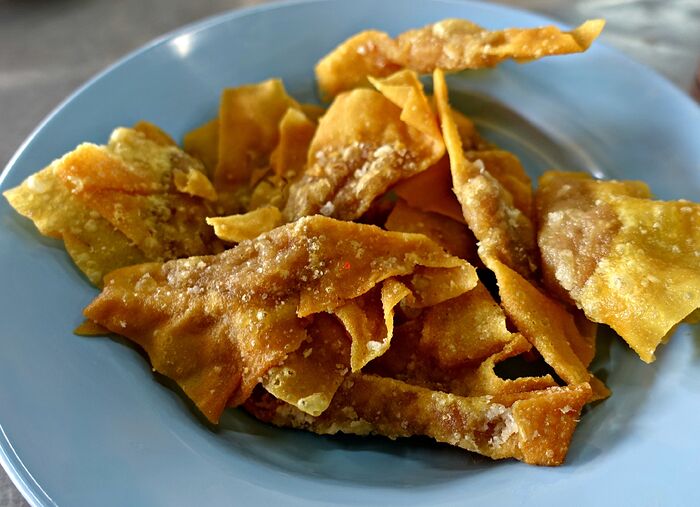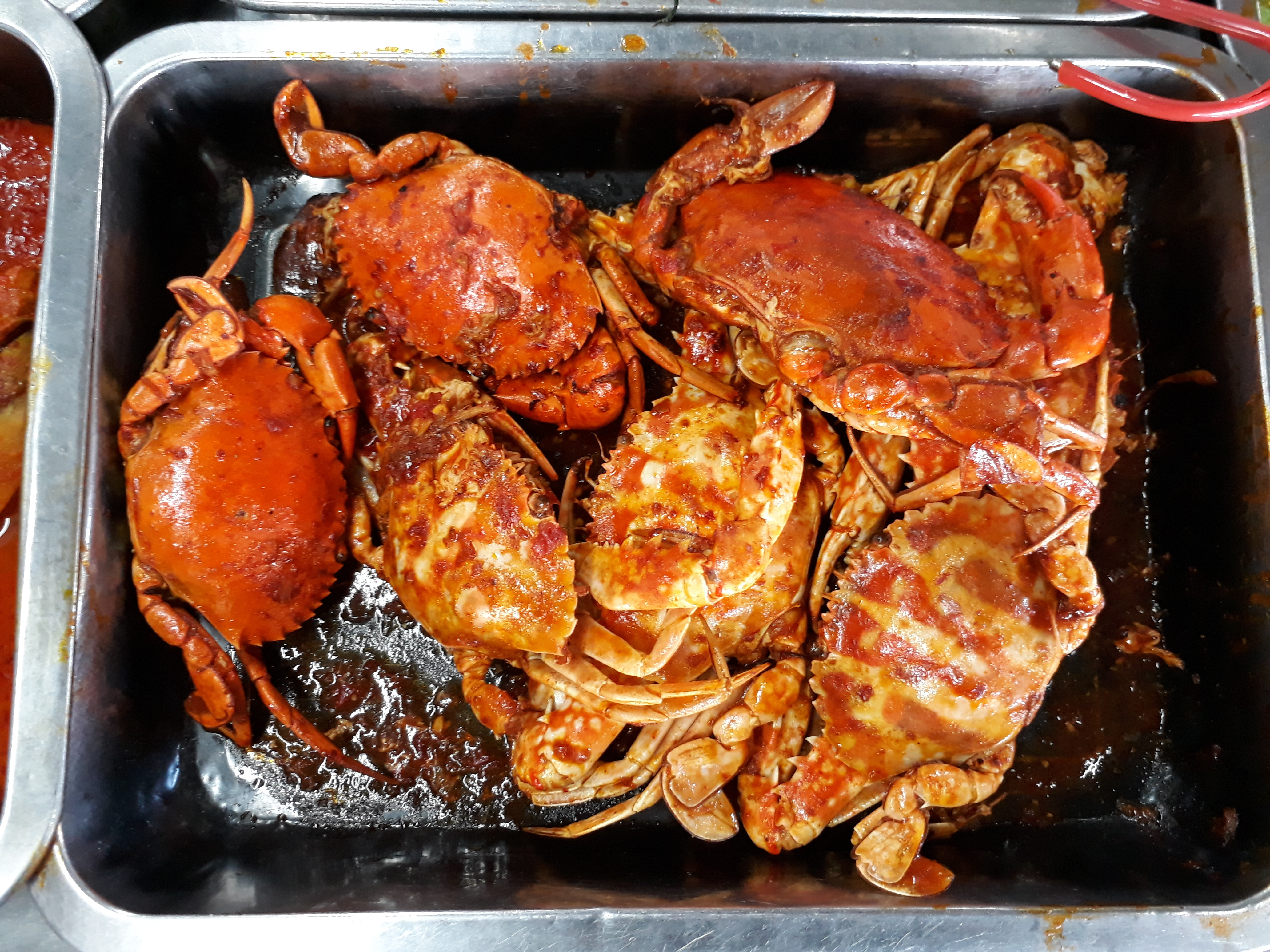Cecil Street Market is known to local Penangites as “Chit Tiau Lor Bansan” (Hokkien lingo meaning Seventh Street Market).
Penangites since the olden days have termed this area, first settled by coolies and working-class immigrants in the 19th-century, as the “7 Streets Precinct”, where The 7 Streets (“Chit Tiau Lor”) are:
1st Street - Thau Tiau Lor = Magazine Road
2nd Street - Ji Tiau Lor = Noordin Road
3rd Street - Sar Tiau Lor = Presgrave Street
4th Street - Si Tiau Lor = Tye Sin Street
5th Street - Gor Tiau Lor = MacCallum Street
6th Street - Lak Tiau Lor = Katz Street
7th Street - Chit Tiau Lor = Cecil Street
Just after Cecil Street are:
8th Street - Pek Tiau Lor = Herriot Street
9th Street - Kau Tiau Lor = Sandilands Street
Our brunch there yesterday:
- Wantan noodles - this is the Penang version, unlike the soupy Hong Kong variety, and much tastier than Singapore’s Hakka-inflected versions. The Penang wantan noodles is a variation upon the Kuala Lumpur version (which happens to be my favourite), i.e. springy thin wheat noodles dressed in pork lard, dark & light soysauces, sesame oil, drippings from the char-siu (caramelised BBQ pork) and various other condiments. Penang wantan noodles are closer to the Hongkong one in terms of its al dente texture.
Truth be told, I never liked Penang wantan noodles, which I regarded as a poorer version of KL’s amazing one. But this stall at Cecil Street Market serves a surprisingly tasty version and one of the best I’d had in George Town.
Only in Penang can one find deep-fried crispy wantan dumplings served atop the wantan noodles, together with poached/boiled wantans. The fried wantans here were also very good, on par with the version I get from Kuala Lumpur’s Ho Weng Kee in Hutong Lot 10.
The wantan noodle stall:
- Duck-meat “koay teow th’ng” - flat rice noodles in a tasty clear broth. There are two categories of this Teochew/Chaozhou dish: the pork version and the duck-meat version. There’s also a less common chicken-meat version.
The version here is the duck-meat version, which comes garnished with typical Teochew accompaniments like fishballs & fishcakes, plus jelly-like duck-blood, pig’s intestines and slivers of poached duckmeat. Topped with golden-fried garlic oil & chopped scallions, it’s fantastic - perhaps the best food option to order at Cecil St Market.
The duckmeat koay teow stall - Lau Lum Lai and his family have been running this stall since the early 70s, and his version is my all-time favourite “koay teow th’ng” in Penang.
- Pasembur, also called “Cheh Hu” in Penang-Hokkien parlance, is a milder Chinese version of what we in Singapore/Malaysia call Indian rojak. Basically a tossed salad of a variety of crisp fritters (cucur & keropok), tofu, julienned cucumbers and jicama, slathered in a tasty tomato-ey sauce thickened with sweet potatoes, this is one of my fave hawker food items in Penang. The version here is very good indeed, though I’d still rate it below the ones from Genting Cafe @ Island Glades (mornings/afternoons only) and Batu Lanchang Market (afternoons only).
I actally much prefer Chinese pasembur over its spicier Indian cousin, like the ones served at Edgecumbe Road, Padang Brown or Fort Cornwallis - all having the best renditions of Indian passembur or Indian rojak in Penang.
The Chinese pasembur stall:
- Curry mee - this is the typical Penang rendition of curried noodles. Each city in Malaysia and Singapore has its own rendition of the curry noodles: in Ipoh, the curry noodles are heavily-flavoured using Indian curry spices, oftentimes served tpped with crisp-skinned roast pork and BBQ “char-siu” pork besides poached chicken-meat; in Kuala Lumpur, curry noodles will contain curried chicken, eggplant, long beans and tofu puffs; whereas in Singapore, curry noodles are slathered in a coconut-rich chicken-and-potato curry.
Penang’s curry noodles is usually a mix of yellow Hokkien wheat noodles and thin rice noodles (beehoon) in a light salty-savoury coconut-scented soup, garnished with pig’s blood cubes, shrimps, blood cockles (similar to the ones used for Singapore Katong laksa), cuttlefish and tofu puffs.
Cecil Street Market has two curry noodles stalls - we tried both and prefered the second stall listed below:
5a) Curry mee #1 - lots of ingredients, but the soup did not have the classic Penang curry mee flavours and had a pungent lemongrass smell/taste which I think do not belong to this category of noodle dish. The dollop of chili spice - which make-or-break a Penang curry noodle dish - is not too bad: piquant and aromatic.
Curry mee stall #1
5b) Curry mee #2 - this version got its flavours down pat. Love it.
Curry mee stall #2
- Cecil Street Market is also where one finds perhaps one of the most famous roast pork/BBQ pork stalls in George Town: May Yong. Come and buy some of its crispy-skinned roast pork (“sio bak”), caramelised BBQ pork (“char siew”), Chinese sausages (“lup cheong”) or grilled pork jerky (“bak kwa”).
- For traditional Nyonya kuehs (sweetmeats), there are two competing rival kueh stalls located side-by-side. Besides the usual steamed kuehs (similar in texture to Thai “khanom”), the stalls also offer curry puffs, steamed savoury taro pudding, etc.
- The Southern Chinese loved to have steamed white rice (instead of noodles as in the case of Northern Chinese) with dishes for lunch. Penang’s largely Hokkien (Fujianese) Chinese populace, together with Teochew, Hakka, Cantonese, Hainanese and Foochow Chinese are all Southern Chinese - so “economy rice” stalls, so-called as they offer plate lunches where one chooses side-dishes to be piled atop a plate of rice, are perhaps the busiest stalls at lunch time. There are two stalls at Cecil Street Market which does bustling business.
Economy rice stall #1:
Economy rice stall #2, which also offers Teochew rice porridge, served from an earthenware urn:
Cecil Street Market opens throughout the day, but the best time is probably between 9am and 12 noon, when most of the stalls are operating at full steam, but the peak breakfast and lunch crowds are not present.
Address
Cecil Street Market (七条路巴刹)
40-48, Lebuh Cecil (Cecil Street), 10300 George Town, Penang, Malaysia
Operating hours: 7.30am - 7pm, daily.









































